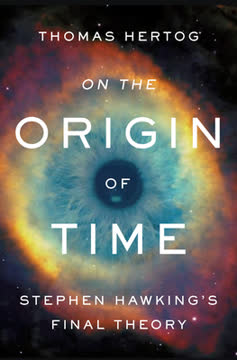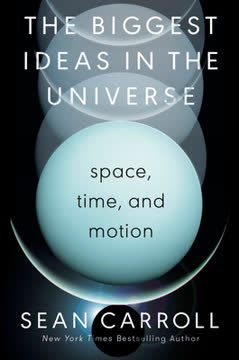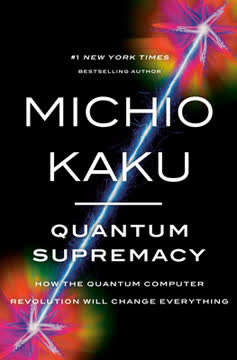Key Takeaways
1. Cosmology's Maturing: From Speculation to Observation
In cosmology we discover the past.
Cosmology's evolution. Once considered a realm of unrestrained speculation, cosmology has matured into a rigorous science, driven by spectacular observations from sophisticated satellites and Earth-based instruments. This transformation allows scientists to trace the universe's history of expansion and glean insights into its origin, evolution, and fate.
Telescopes as time machines. Cosmologists are time travelers, using telescopes to look back into deep time. The light from distant stars and galaxies has traveled millions or billions of years to reach us, providing a glimpse into the universe's past. This allows scientists to study the cosmic microwave background radiation (CMB), a relic of the hot big bang, and decipher patterns encoded within it.
Key observations:
- Expansion of space: Predicted by Lemaître in 1927 and confirmed by Hubble's observations.
- Cosmic microwave background radiation: A snapshot of the universe 380,000 years after the big bang.
- Accelerating expansion: Discovered in 1998, suggesting the presence of dark energy.
2. The Uncanny Biofriendliness of the Universe
It appears as if the universe has somehow been designed to make life possible.
Fine-tuning for life. The universe exhibits an extraordinary fitness for life, with its fundamental physical properties seemingly engineered to facilitate the emergence of living organisms. This "Goldilocks factor" is evident in the strength of gravity, the temperature variations in the CMB, the number of spatial dimensions, and the chemical properties of elements.
Examples of cosmic coincidences:
- Gravity: If stronger, stars would die too quickly for complex life to evolve.
- CMB temperature variations: If larger, giant black holes would dominate; if smaller, no galaxies would form.
- Neutron-to-proton mass ratio: A slight change would prevent the formation of atoms.
- Dark energy density: A larger value would have prevented galaxy formation.
The riddle of design. The fundamental laws of physics appear specifically engineered to facilitate the emergence of life. This raises profound questions about the deeper nature of the laws and our place within their scheme.
3. Relativity's Revolution: Spacetime and Gravity
Henceforth space as such and time as such shall recede completely to the shadows and only a kind of union of the two shall retain independence.
Einstein's spacetime. Einstein's theory of special relativity revolutionized our understanding of space and time, merging them into a single four-dimensional entity called spacetime. This framework introduced the concept of a cosmic speed limit (the speed of light) and redefined our relationship with the universe.
General relativity and gravity. Einstein's theory of general relativity describes gravity as a manifestation of the curving and bending of spacetime by mass and energy. This geometric interpretation of gravity explains phenomena such as the bending of light around massive objects and the existence of black holes.
Key concepts:
- Spacetime: A four-dimensional union of space and time.
- Light cones: Structures that define an observer's past and future.
- Event horizon: The boundary of a black hole, beyond which nothing can escape.
- Gravitational waves: Ripples in spacetime caused by accelerating masses.
4. The Big Bang's Paradox: A Beginning Beyond Understanding
We can compare spacetime to an open, conic cup.
Lemaître's primeval atom. Georges Lemaître proposed that the universe began with a primeval atom, a tiny speck of staggering density whose disintegration created matter, space, and time. This idea, initially met with skepticism, laid the foundation for the big bang theory.
The singularity problem. The big bang theory implies a singularity at the origin of time, where spacetime curvature becomes infinite and the laws of physics break down. This poses a paradox: how can the laws of physics determine the universe's origin if they don't apply at the singularity?
Quantum indeterminacy. Lemaître speculated that quantum indeterminacy could resolve the causality conundrum posed by the big bang. Random quantum jumps could have generated a complex universe from a simple primeval atom, making the idea of a beginning easier to accept.
5. Quantum Cosmology: A Blend of Gravity and Uncertainty
Clearly the initial quantum could not conceal in itself the whole course of evolution.
Merging relativity and quantum theory. Quantum cosmology seeks to reconcile general relativity and quantum theory to understand the universe's origin. This requires a new framework that goes beyond the traditional separation of laws and conditions.
Hawking's no-boundary proposal. Stephen Hawking and Jim Hartle proposed that the universe has no boundary in the past, replacing the initial singularity with a smooth, rounded quantum origin. This implies that time itself emerges from a deeper, timeless state.
The role of quantum fluctuations. Quantum fluctuations, amplified by inflation, are thought to have seeded the formation of galaxies and large-scale structures in the universe. These fluctuations also contribute to the temperature variations in the CMB.
6. The Multiverse and the Anthropic Principle: A Contentious Debate
The anthropic principle is a counsel of despair.
The multiverse concept. The multiverse theory suggests that our universe is just one of many, each with its own physical properties. This arises from inflationary theory, which tends to generate not one but many universes.
The anthropic principle. The anthropic principle states that we observe the universe the way it is because we exist. It suggests that selection effects play out across the multiverse, favoring universes suited for life.
Criticisms of the anthropic principle:
- Compromises the scientific process of prediction and falsification.
- Introduces a subjective element into physics.
- Fails to explain why the metalaws of the multiverse are what they are.
7. Hawking's Top-Down Cosmology: A New Perspective
The history of the universe depends on the question you ask.
A worm's-eye view. Hawking's top-down cosmology rejects the God's-eye view, emphasizing that we are within the universe, not outside it. This requires a new philosophy of physics that accounts for our inherent limitations as observers.
Rethinking the laws of physics. Top-down cosmology suggests that the laws of physics are not immutable, timeless truths but rather emergent properties of the universe, shaped by its evolution and our observations. This implies a retrospective element in cosmology, where the present influences our understanding of the past.
Key elements:
- Rejection of a global classical state.
- Emphasis on the interconnectedness of the universe.
- Recognition of the role of observership in shaping reality.
8. Holographic Universe: Information on the Surface
The fabric of existence weaves itself whole.
Holographic principle. The holographic principle suggests that the information content of a volume of space can be encoded on its boundary surface. This implies that the universe may be a hologram, with all its complexity projected from a lower-dimensional surface.
Black holes and holography. The entropy of a black hole is proportional to the area of its event horizon, suggesting that black holes store information on their surface. This led to the holographic duality, which relates gravity in a volume of space to a quantum field theory on its boundary.
Implications for cosmology. Holographic cosmology suggests that the universe's history and properties are encoded on a distant boundary, challenging our understanding of space, time, and causality.
9. The Arrow of Time: From Order to Disorder
I hardly move, yet far I seem to have come.
The entropic arrow. The arrow of time arises from the tendency of disorder to increase, as measured by entropy. The second law of thermodynamics states that entropy always increases in a closed system.
The mystery of low entropy. The universe began in an extremely ordered, low-entropy state. This raises the question of why the initial conditions were so special and how the arrow of time emerged.
Quantum indeterminism. Quantum indeterminism could have generated a complex universe from a simple primeval atom. If the complexity of today’s universe were the result of countless frozen accidents in its embryonic evolution rather than the necessary consequence of perfectly orchestrated initial conditions right at the start, wouldn’t the whole idea of a beginning be easier to swallow?
10. The Quest for a Unified Theory: String Theory and M-Theory
Mathematics “takes you by the hand,” he said, “to discover new physical theories.
The Standard Model. The Standard Model of particle physics describes all known matter particles and the three forces that govern their interactions (electromagnetic, weak, and strong). However, it doesn't include gravity or dark matter.
String theory and M-theory. String theory attempts to unify all forces, including gravity, by replacing point-like particles with tiny vibrating strings. M-theory is a web of interconnected string theories that offers a more complete picture of the universe.
The multiverse landscape. String theory predicts a vast landscape of possible universes, each with its own physical laws. This raises the question of why our universe has the specific properties that it does.
11. The Fate of Information in Black Holes: A Quantum Puzzle
I am dying…for…a…cup…of…tea.
Hawking radiation. Black holes emit a faint trickle of thermal radiation, known as Hawking radiation, due to quantum effects near their event horizon. This radiation causes black holes to slowly evaporate over time.
The information paradox. The evaporation of black holes raises a paradox: what happens to the information that falls into a black hole when it disappears? Quantum theory says information cannot be destroyed, but Hawking's calculations suggested it was lost forever.
Holographic resolution. The holographic principle offers a potential resolution to the information paradox. It suggests that the information content of a black hole is encoded on its event horizon, and that this information is preserved in the Hawking radiation.
12. The Humanistic Implications: Reclaiming Our Place in the Cosmos
We are together, the universe and us.
The limitations of a God's-eye view. Arendt argued that the pursuit of objective knowledge in science can lead to earth alienation, a loss of connection to our human condition. This is because it is as if we are looking down on the world and our activities as if we are outside it.
A worm's-eye perspective. Hawking's final theory embraces a worm's-eye perspective, recognizing that we are part of the universe we are trying to understand. This requires a new approach to cosmology that integrates observership and acknowledges the finitude of our knowledge.
Reclaiming our place. By embracing our human perspective, we can reclaim our sense of belonging to the cosmos and find meaning in our existence. This requires a shift from seeking a final theory to understanding the interconnectedness of all things.
Last updated:
FAQ
What is On the Origin of Time: Stephen Hawking's Final Theory by Thomas Hertog about?
- Exploration of cosmic origins: The book traces the evolution of cosmology from classical to quantum, focusing on Stephen Hawking’s final theory about the origin of time and the universe.
- Integration of quantum mechanics and gravity: It explores how quantum mechanics, gravity, and the act of observation are woven into a new framework for understanding the cosmos.
- Debate on universe vs. multiverse: Hertog presents the scientific and philosophical debates around the multiverse, the anthropic principle, and Hawking’s skepticism of these ideas.
- Radical new perspective: The narrative introduces a Darwinian-like evolution of physical laws, challenging the traditional view of immutable, Platonic laws of physics.
Why should I read On the Origin of Time by Thomas Hertog?
- Insider’s view of Hawking’s legacy: The book offers a unique, intimate perspective on Stephen Hawking’s final scientific ideas, based on Hertog’s two-decade collaboration with him.
- Bridges science and philosophy: It connects complex physics with philosophical questions about time, existence, and humanity’s place in the universe.
- Clarifies modern cosmology: Readers gain a deeper understanding of quantum cosmology, the multiverse controversy, and the ongoing quest for a predictive theory of the universe.
- Humanistic reflections: The book also explores the implications of these theories for human meaning, freedom, and our relationship with the cosmos.
What are the key takeaways from On the Origin of Time by Thomas Hertog?
- Physics as evolutionary: The book argues that physical laws are not fixed but have evolved through quantum processes in the early universe.
- Limits of predictability: It highlights the challenges posed by the multiverse and anthropic reasoning to scientific testability and explanatory power.
- Human significance: Hawking’s final theory is presented as a humanist quest, emphasizing our embeddedness and creative role in the universe’s history.
- New cosmological framework: The book introduces top-down and holographic cosmology as alternatives to traditional, bottom-up approaches.
What is the significance of the big bang and the origin of time in On the Origin of Time by Thomas Hertog?
- Big bang as time’s beginning: Hawking’s singularity theorems show that the universe had a beginning where time itself started, not just matter or space.
- Quantum “no-boundary” origin: The book explains how quantum mechanics replaces the classical singularity with a smooth, boundary-less quantum origin, removing the need for a “first cause.”
- Arrow of time: The universe’s low-entropy initial state sets the directionality of time and underpins its life-friendly properties, a profound mystery explored in the book.
How does On the Origin of Time by Thomas Hertog explain the apparent fine-tuning or design of the universe?
- Biofriendly universe puzzle: The book discusses why the universe’s physical laws and constants seem exquisitely tuned for life, a longstanding scientific and philosophical riddle.
- Critique of Platonic laws: Hertog and Hawking challenge the idea that physical laws are timeless and immutable, suggesting instead that they evolved in the early universe.
- Darwinian evolution of laws: The theory proposes that physical laws emerged through a process akin to natural selection, reframing cosmic design as an outcome of cosmic evolution.
What is the multiverse, and how does On the Origin of Time by Thomas Hertog critique it?
- Definition of the multiverse: The multiverse is a theoretical concept where our universe is just one of many, each with different physical laws and constants.
- Hawking’s skepticism: The book recounts Hawking’s view that the multiverse lacks predictive power and scientific testability, making it more metaphysical than scientific.
- Problems with the anthropic principle: Hertog critiques the use of the anthropic principle in multiverse cosmology, arguing it introduces subjectivity and undermines falsifiability.
What is the anthropic principle, and why does On the Origin of Time by Thomas Hertog critique its use in cosmology?
- Definition and application: The anthropic principle suggests that the universe’s constants appear fine-tuned for life because only in such universes can observers exist to notice them.
- Subjectivity and ambiguity: The book explains that anthropic reasoning depends on arbitrary choices about what counts as an “observer,” leading to ambiguous predictions.
- Measure problem: Without a clear way to weigh different universes or observers, anthropic multiverse cosmology lacks scientific rigor and predictive power.
What is the no-boundary proposal in On the Origin of Time by Thomas Hertog, and how does it relate to the universe’s origin?
- Quantum origin without boundary: The no-boundary proposal, developed by Hawking and Hartle, suggests the universe has no initial boundary or singular starting point in time.
- Smooth, finite geometry: Time “rotates” into space near the origin, creating a bowl-like geometry where the question of “what came before” becomes meaningless.
- Unified framework: The no-boundary wave function blends initial conditions and dynamics, predicting a universe born with a burst of inflation.
What is top-down cosmology as presented in On the Origin of Time by Thomas Hertog?
- Backward-in-time reasoning: Top-down cosmology starts from present observations and works backward to infer the universe’s history, rather than assuming a fixed initial state.
- Role of observership: The act of observation is fundamental, “pruning” possible histories and making the past contingent on present measurements.
- Resolution of cosmological puzzles: This approach avoids multiverse paradoxes by focusing on the specific history of the observed universe.
How does On the Origin of Time by Thomas Hertog explain the role of quantum mechanics in cosmology?
- Quantum superposition of histories: The universe is described as a superposition of many possible spacetimes, each with its own probability.
- Everett’s many-worlds interpretation: The book discusses how quantum measurement causes the universal wave function to branch into distinct, decoherent histories.
- Observership as a physical process: Observation is not external but part of the quantum system, selecting particular outcomes and giving rise to definite reality.
What is holographic cosmology according to On the Origin of Time by Thomas Hertog?
- Universe as a hologram: The book explains that our universe can be described as a hologram, with a lower-dimensional boundary encoding all information about the higher-dimensional bulk.
- Emergence of time and space: Time and the expanding universe emerge from quantum entanglement patterns on the boundary, making time itself emergent rather than fundamental.
- Unified quantum cosmology: Holography integrates histories, genesis, and observership into a single, more predictive framework.
What are the philosophical and humanistic implications of On the Origin of Time by Thomas Hertog?
- Critique of objectivity: The book echoes concerns that the scientific pursuit of a detached, objective viewpoint can lead to alienation and diminish human meaning.
- Human-centered perspective: Hawking’s final theory embraces our embeddedness in the universe, restoring a sense of belonging and responsibility.
- Pluralistic, evolving worldview: The theory suggests that humans are co-creators of the universe’s history, inspiring a renewed sense of purpose and stewardship.
Review Summary
On the Origin of Time explores Stephen Hawking's final cosmological theory, developed with Thomas Hertog. Readers find it fascinating yet challenging, praising Hertog's accessible writing style. The book examines quantum physics, holographic universe concepts, and a top-down approach to cosmology. It offers insights into Hawking's life and scientific process. While some struggle with complex concepts, many appreciate the book's thought-provoking ideas and historical context. Reviews are generally positive, with readers valuing the updated perspective on Hawking's earlier works.
Similar Books
Download PDF
Download EPUB
.epub digital book format is ideal for reading ebooks on phones, tablets, and e-readers.









